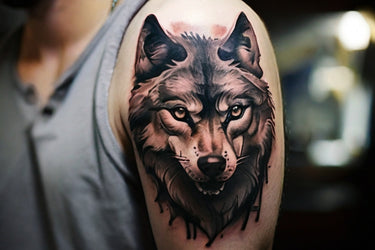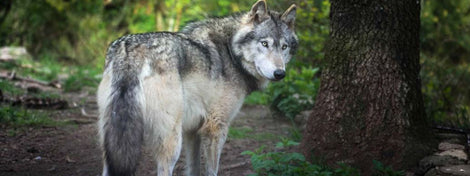WHICH DOG BREED IS CLOSEST TO THE WOLF?
1. Canis lupus, the same species
Thanks to DNA analysis, scientists have established that the wolf is the ancestor of the dog. They belong to the same species, the Canis Lupus. Scientists initially thought that all dogs were descended from a single wolf pack in China. Indeed, the Chinese were one of the first people to breed dogs: the Shar-Pei (which means sand skin in French). It was an effective war dog millennia ago, which unfortunately was also used as a fighting dog.

A beautiful Shar-peï and his master in the 50s
However, recent research indicates that many different civilizations have domesticated dogs at various times. Another theory from 2017 reveals that dogs have been domesticated from 2 different wolf packs. One in Asia, the other in Europe. The dog was moreover with the Lama the only animal present on the American continent, before the arrival of the colonists. One can legitimately question this theory. The Indians used them as an aid to transport before the arrival of the wheel and would vein without limit the Indian wolf, symbol of supreme divinity. We pay tribute to them with this Indian wolf T-shirt and with our collection of Indian wolf plaids.
Genetic similarity
According to Dr. Robert Wayne, a canine biologist and molecular geneticist at the University of California, Los Angeles, modern dogs differ from gray wolves by only 0.2% of their DNA. This is a very small difference, since the closest wild relative of wolves is the coyote, which differs genetically by 4%. So dogs are genetically 20 times more closely related to wolves than coyotes are. There are even some genetic similarities between wolves and dogs that reach 99.9%.
A distant and difficult to identify ancestor
Despite this genetic link that clearly shows the connection between the gray wolf and modern dogs, thousands of years of interbreeding and evolution make it difficult to identify one breed as being closer to the wolf than another.
Although it is difficult to determine exactly which breeds are most closely related to the wolf, the CanMap project initiated in 2010 has identified the dog breeds most closely related to the wolf. Scientists collected DNA from nearly 1,000 dogs of 85 breeds for gene analysis. And the results are... Surprising!
2. Modern dogs from the wolf
They got canine genetics to talk and found that the four dogs most closely related genetically to their wolf ancestors are:
- The Shiba Inu
- The Chow Chow
- The Akita
- The Alaskan Malamute

This study was conducted on only 85 breeds. Future studies done on a larger number of breeds may indicate different results.
We all agree that the Shiba is not the most ferocious and wild dog.
Dogs are not only considered man's best friend, but scientists have long known that they are also man's first friend. Dogs were the first domesticated animals. Although the exact timeline of dog domestication is not known, researchers at Durham University in England estimate that dogs were domesticated about 15,000 years ago, even before the advent of agriculture. The common ancestor of the wolf and the dog thus gave birth to 2 subspecies of canids.
3. The legacy of the wolf on the canine descendants
There has been so much interbreeding in recent history that modern dogs have little genetic resemblance to their canine ancestors. It is virtually impossible to trace a direct link between a breed and a wolf.
Is the gray wolf the exclusive ancestor of the dog?
There are several competing theories about the descent of dogs and gray wolves.

The European Lupa DNA research team determined that the gray wolf was the ancestor of most dogs including the Golden Retriever, English Bulldog and Basset Hound. Our modern dogs have little in common in terms of behavior and appearance compared to dogs of only a few hundred years ago. It is only in the last 100 years that we have really begun to breed pets into dog breeds.
Modern dogs have been bred for specific tasks and in the last few centuries in particular, they have been bred for specific personality traits as pets. This continuous, specific and crossbred character has completely changed them from the wild wolves they once were.
What is left of the wolf?
The differences between wild wolves and dogs are primarily due to forced human domestication. The most common hypothesis is that humans tamed the wolf for use as a hunting companion and then as a protection animal. An observational study in 2017 found differences in cooperation with humans on a group of 15 dogs and 12 wolves. According to the authors of the study, "wolves pay as much attention to humans and their fellows as dogs do, and may even surpass them in learning through observation of a conspecific." They also state that "dogs cooperate more easily because they accept humans as social partners".
A proof that the wolf remains and must remain a wild animal! If the wild and protective side of the wolf fascinates you, you can pay homage to it with this splendid grey wolf painting or this cozy grey wolf blanket.









